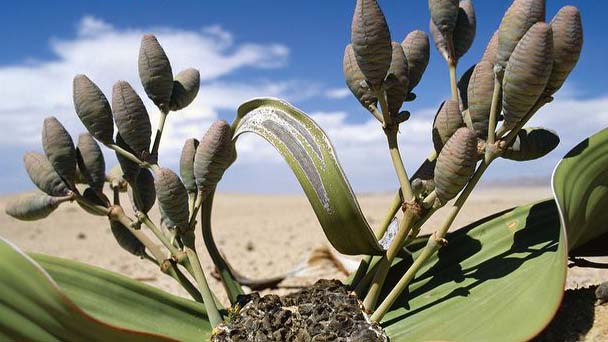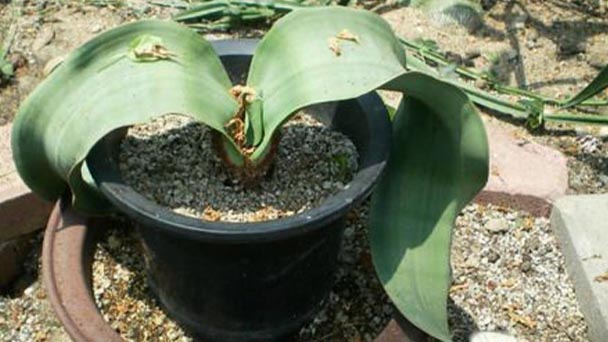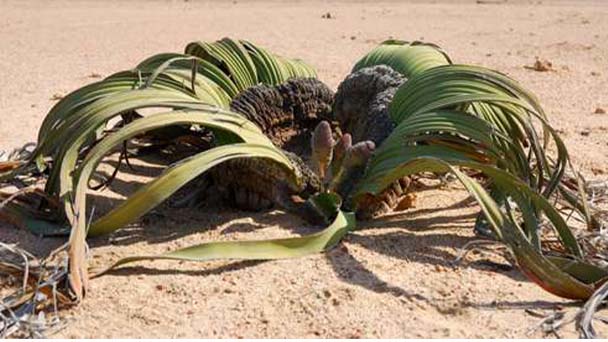Welwitschiales Profile
Written by Joy
Jan 26 2021

Welwitschiales is a gymnospermous plant of the order Centenaria. There is only one species of this genus, Welwitschiales. Welwitschiales is not really an orchid, it is the only meaty plant in gymnosperms, the ancestor of the Chinese plant science Dr. Hu Xian Su called it the most unusual desert plant. Welwitschiales produces more than 10,000 seeds a year, but only 1 percent can grow into seedlings. The average life expectancy of the Welwitschiales is 500 to 600 years, with a few living for around 2000 years.


Welwitschiales morphological characteristics
Welwitschiales grows in the desert of southwest Africa, the shape is strange, and Welwitschiales's stem is short and thick, only one or two centimeters high, but the stem circumference is up to 4 meters. The Welwitschiales leaves are soft from the beginning to adapt to the arid desert environment, gradually becoming leathery. The apex of the Welwitschiales leaf gradually withered, the flesh decayed, the remaining woody parts of the leaf curved in coils, and the thick and short Welwitschiales stems which from a distance, one might have thought were Voldemort's monsters.Welwitschiales growth habit and growing environment and distribution
Welwitschiales was discovered by Austrian botanist Friedrich Welwitsch in 1860 in the Nambi Desert in southern Angola. Welwitschiales is a very strange plant, growing in very bad conditions, with less than 25mm of rainfall a year, and the equivalent of only 50mm of fog from the sea. The oldest Welwitschiales are estimated to be between 1500 and 2000 years old. Welwitschiales can tolerate extremely harsh conditions. Most Welwitschiales grow in a foggy area about 80 kilometers from the coast, so it is estimated that fog is Welwitschiales's main source of water.Welwitschiales is a gymnospermous plant, and its relationship with other plants remains to be studied. Welwitschiales is found only in the Nanb Desert. The Namib Desert is the oldest desert in the world, and Welwitschiales range from the western coast of Namibia to an extremely dry stretch of the desert southwest of Angora.
Welwitschiales cultivation
The Welwitschiales is dioecious. The female Welwitschiales have large female cones, and the male Welwitschiales have male flowers, each of which has six stamens. Pollen is carried by the wind, but there's also a small insect playing a role. The average female Welwitschiales can produce 60 to 100 female cones and up to 10,000 seeds. The Welwitschiales seeds have paper wings and are spread by strong winds. Most of Welwitschiales seeds will not germinate because assuming that 50% of them are active, 80% of Welwitschiales will be infected by the fungus. It is estimated that less than one in ten thousand seeds will germinate and grow into a full Welwitschiales. Too much moisture will prevent seeds from germinating and give off a foul odor.Welwitschiales flower language
Welwitschiales, a Sanskrit word for orchid, means an orchid hanging from a tree. Our country translates it as Welwitschiales, because Welwitschiales has the tenacious vitality, the implication is handed down forever from generation to generation.Latest Updated
- Benefits of Bugleweed - 7 Science-backed Health Benefits
- Bugleweed Dangers & Side Effects - Is It Poisonous?
- How to Plant Evergreen Trees - What You Should Know
- When to Plant Evergreens - Grow Guide for Evergreen Trees
- 12 Wonderful Evergreen Shrubs for Your Garden
- 12 Popular Evergreen Plants with Pictures for Beginners
- When And How To Prune A Lilac Bush Like a Pro
- How to Grow & Care for Lilac Vine (Hardenbergia Violacea)
- Japanese Lilac Tree (Syringa Reticulata) Care & Propagation Guide
- Shumard Oak Pros and Cons - What to Know
Popular Articles
- Winter maintenance of Antirrhinum Majus
- How to Grow Terminalia Mantaly Tree
- How to Grow and Care for Crossostephium Chinense
- How to grow Antirrhinum Majus in spring
- Peristeria Elata (Dove Orchid) Profile: Info & Care Guide
- Underwatered Snake Plant (Sansevieria Trifasciata) - Signs And How To Fix
- How to Care for Brazilian Jasmine Plant (Mandevilla Sanderi)
- How to Grow & Care for Graptopetalum Purple Delight in Summer
- Rosa Chinensis (China Rose): Plant Growing & Care Tips
- How to Care for Baby Sun Rose (Aptenia Cordifolia)